Apple's MacBook Pro: Using it as a Mac and a PC
by Anand Lal Shimpi on April 13, 2006 12:00 AM EST- Posted in
- Mac
Parallels' Workstation 2.1 Beta w/ Intel VT Support
The biggest downside to Boot Camp is that you have to reboot your system in order to use it. That means you've got to save all of your work, close down all of your apps, stop what you've been working on and head on into Windows. While Boot Camp is extremely convenient for those users who are debating the Mac switch but are worried about going cold turkey, in the long run it's only convenient for those who are going to occasionally be switching between the two OSes.
Even before Boot Camp, Virtual PC and other PC emulators have existed for Mac users that needed to run Windows. The emulators would generally work in a window inside OS X and you could do things like copy text between the two OSes, but most importantly you could run and use Windows without ever logging out of OS X. The downside of course is that performance under emulators like Virtual PC is often terrible, which makes them frustrating to use, especially on slower laptop hardware. Luckily, modern day Intel CPUs - including the Core Duo used in Intel based Macs - support Intel's Virtualization Technology (VT for short) which is designed to make the job of a virtual machine a bit easier and thus increase performance.
One developer of Virtualization software, Parallels, Inc., has released a beta of Virtualization software for OS X with support for Intel's VT. Parallels' solution offers the first hardware accelerated virtualization software for OS X, meaning in theory you should be able to run Windows XP alongside OS X and get almost the same performance as you would if you were using Boot Camp.
Currently Parallels' Workstation 2.1 for Mac OS X is only available as a free trial of Beta 2. It will eventually be sold for $49.99 and you can pre-order it now for $39.99. As a Virtual Machine Manager (VMM), Parallels' Workstation installs from within OS X and doesn't require any reboots or anything like that.
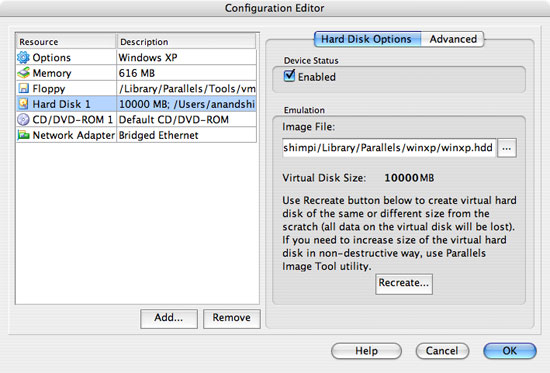
You simply install the application and then start configuring your virtual machines. Although I only played with a Windows XP VM, you can run any version of Windows from 3.1 all the way up to 2003 Server, as well as any Linux distribution, FreeBSD, Solaris, OS/2, eComStation or MS-DOS.
Parallels' Workstation automatically detects and enables Intel VT support if it's present, so there's nothing MacBook Pro users need to do differently to get the most performance out of the hardware. Creating a Windows XP VM requires just a few decision: how big should the hard drive be, how much memory should be allocated to the VM, and what network controller will the VM use? Make those decisions and configure the VM appropriately, and everything is ready for use.
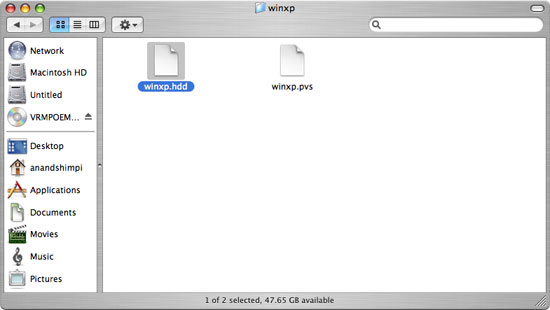
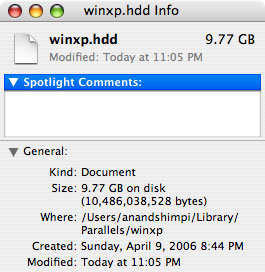
Like my Boot Camp partition, I chose a 10GB drive for the XP VM. The VM's hard drive is treated as a single file in OS X so you don't need to worry about creating any partitions. The VM manager recommended I set aside 616MB of memory for Windows XP and for testing purposes I did just that, although if you really plan on using Windows alongside OS X for a lot of work then I would suggest upgrading to 2GB in your MacBook Pro.
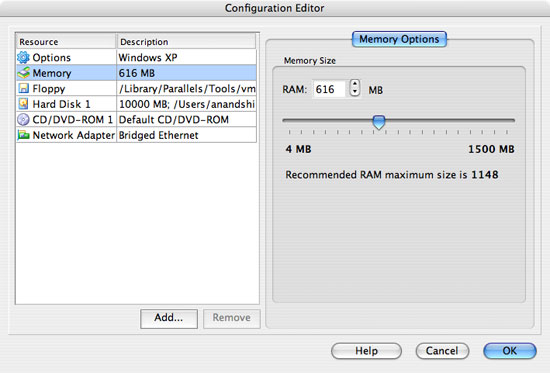
I allowed the VM to use my wireless connection and it appeared as a normal wired Ethernet connection in Windows XP. All network requests that are sent to that virtual network adapter are handed off to the VM which in turn requests them through the wireless adapter in OS X. However the VM manager only lets you bridge a single network connection, so on the MacBook Pro you can only make either your wired or wireless connection available to your VM. Luckily, it's not difficult at all to change this option so it's not too annoying.
Unfortunately I couldn't get the VM to let Windows XP access my CD/DVD drive, so I was forced to make an image of my Windows XP CD to install it. Using OS X's Disk Utility I created a CD/DVD Master image of my Windows XP SP2 disc and renamed it from a .cdr to .iso so the VM would recognize it. I selected it as my CD image and fired up the VM. (This has since been fixed in Beta 3 of Parallels' Workstation 2.1 for OS X.)
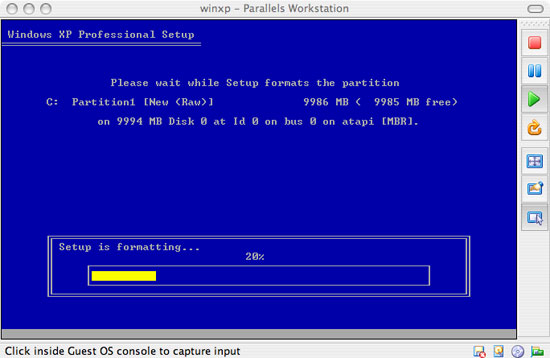
Since the Windows XP image was actually on my hard drive the setup process went extremely fast. With Windows installed, it was time to use it.










52 Comments
View All Comments
Calin - Thursday, April 13, 2006 - link
This could be thanks to slower drivers in BootCamp Windows XP, or slower hard drive access/speed. Everything else is a disadvantage for VM: one more level of indirection in disk access, less memory, running the OS X behind the VM.Could you do some disk speed comparation between VM and native XP?
BigLan - Thursday, April 13, 2006 - link
I think it's going to be hard drive speed throwing off the benchmarks. The BootCamp partition is going to be at the outer edge of the disk, with much slower speeds than the VM client virtual drive which is on the faster Apple partition.I'm not sure if it's possible to assign the entire HD to a windows partition using Bootcamp, but that's about the only way i can think of to level the playing field.
Calin - Friday, April 14, 2006 - link
To nitpick, it would be at the center of the hard drive, not at the outer edge :) (ok, based on sector numbers, which starts at the edge).Near the "end" of the hard drive, the transfer speed is reduced (there are fewer bytes on a full circle).
jimmy43 - Thursday, April 13, 2006 - link
Excellent Review. This may be my first laptop purchase, seems to have everything I could possibly want.monsoon - Thursday, April 13, 2006 - link
Hello Anand,...i'm waiting for Parallels to finalize their VT release and maybe Merom Macs too...
I was wondering if the ONE CORE only VT tech is to be the final result of their virtualization software or just a middle-step.
Seems to me it's rather poor a solution ( ok, it's the best out there for now ) to use a dual-core computer to run both OS on a single core
=/
Better would be smart distribution of tasks to the CPU depending on which OS is actually under load...
...any thoughts / info on that ?
Thanks for your nice review !=)
plinden - Thursday, April 13, 2006 - link
Looking at CPU load while running Parallels VM, I see the load spread evenly over both processors (usually < 10% total CPU except at boot, when it reaches 150% CPU). It's just that the VM itself sees itself as running on a single processor.
shuttleboi - Thursday, April 13, 2006 - link
I've read that the ATI X1600 in the Mac can run games well, but only IF you overclock the GPU. I can't imagine the Mac getting any hotter than it already supposedly is, and the idea of overclocking an already hot laptop is not appealing.JoKeRr - Thursday, April 13, 2006 - link
Overall I enjoyed it.Would have been nice to see a comparison of screen brightness, as apple claimed 67% brighter!
And also, the slowness in windows, could it be related to chipset driver stuff?? And what's the gaming experience so far like?? Would it be similar to a desktop 6600 or 6600gt??
Thank you.
rolls - Friday, April 14, 2006 - link
Very interesting numbers all round.35% improvement in iTunes when comparing a single core 1.5GHz 7447 with the old slow bus etc, and a new 33% faster dual core intel CPU. 50% improvement in H.264 encoding etc. These numbers suggest that had Apple stuck with Freescale and moved to e600 core based systems, performance figures could have been off the scale. If only...
JarredWalton - Thursday, April 13, 2006 - link
On paper the X1600 Pro desktop cards actually look pretty decent. 12 pipelines at 500 MHz, with 800 MHz RAM. I would have thought they would at least give the 6600GT a run for the money, given how X1800 compares to 7800. Amazingly (to me), the X1600 gets completely stomped by the 6600GT. What's worse, the cards I have can't even overclock worth a darn on the memory side - 800 is stock, and they get unstable at even minor changes. (Could be an issue with the overclocking tool, though?)Anyway, for now I would say X1600 Mobility is going to be somewhere in the realm of 6600 (non-GT) performance, maybe slightly faster. That means gaming is definitely possible, but you will want low-to-medium detail levels for any recent titles. Just a guess, of course, and Anand will have to run benches to get any final confirmation. Really, though, this laptop isn't intended as anything more than a light gaming solution.